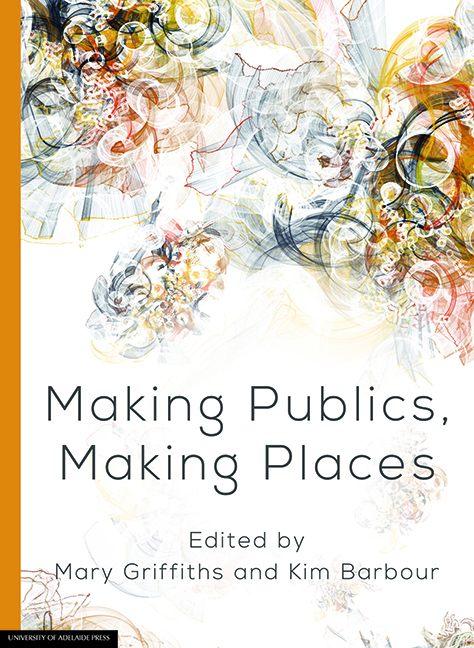Book contents
- Frontmatter
- Contents
- Preface
- Abstracts
- List of contributors
- 1 Making publics, making places
- 2 The elasticity of the public sphere: Expansion, contraction and ‘other’ media
- 3 ‘Imagine if our cities talked to us’: Questions about the making of ‘responsive’ places and urban publics
- 4 Picturing placelessness: Online graphic narratives and Australia's refugee detention centres
- 5 Reclaiming heritage for UNESCO: Discursive practices and community building in northern Italy
- 6 Find your Adelaide: Digital placemaking with Adelaide City Explorer
- 7 Chinese films and the sense of place: Beijing as ‘Thirdspace’ from In the Heat of the Sun to Mr Six
- 8 Social media and news media: Building new publics or fragmenting audiences?
- 9 The use of Chinese social media by foreign embassies: How ‘generative technologies’ are offering opportunities for modern diplomacy
- 10 An opinion leader and the making of a city on China's Sina Weibo
- 11 Public audiencing: Using Twitter to study audience engagement with characters and actors
- 12 Overcoming the tyranny of distance? High speed broadband and the significance of place
5 - Reclaiming heritage for UNESCO: Discursive practices and community building in northern Italy
Published online by Cambridge University Press: 28 July 2017
- Frontmatter
- Contents
- Preface
- Abstracts
- List of contributors
- 1 Making publics, making places
- 2 The elasticity of the public sphere: Expansion, contraction and ‘other’ media
- 3 ‘Imagine if our cities talked to us’: Questions about the making of ‘responsive’ places and urban publics
- 4 Picturing placelessness: Online graphic narratives and Australia's refugee detention centres
- 5 Reclaiming heritage for UNESCO: Discursive practices and community building in northern Italy
- 6 Find your Adelaide: Digital placemaking with Adelaide City Explorer
- 7 Chinese films and the sense of place: Beijing as ‘Thirdspace’ from In the Heat of the Sun to Mr Six
- 8 Social media and news media: Building new publics or fragmenting audiences?
- 9 The use of Chinese social media by foreign embassies: How ‘generative technologies’ are offering opportunities for modern diplomacy
- 10 An opinion leader and the making of a city on China's Sina Weibo
- 11 Public audiencing: Using Twitter to study audience engagement with characters and actors
- 12 Overcoming the tyranny of distance? High speed broadband and the significance of place
Summary
Study design
This research arises from an interest in heritage preservation in the public sector and, in particular, from the awareness of the key role heritage discourse can play as a tool for social inclusion in urban policy and planning. It reflects on the contribution of new media to what could be called ‘the invention of heritage’ in the line of Hobsbawm's ‘invention of tradition’ (1983), showing how heritage is discursively constructed to provide not just an objective historical truth, but collective memories. The selected area of analysis is the contribution of new media communication to the making and remaking of a UNESCO World Heritage site.
UNESCO's protection of World Heritage Sites was inaugurated by the Convention Concerning the Protection of the World Cultural and Natural Heritage, commonly known as the World Heritage Convention (UNESCO 1972), which elevated national symbols into items of ‘outstanding universal value’ and property of all mankind, thereby corroborating an essentialist view of the past (Paganoni 2015b). Since then the approach has changed, expanding the meaning of heritage from the protection of historic buildings and monuments towards a more general understanding of the wider context and preservation of tangible and intangible cultural forms. This wider approach was ratified first in 1992 by the World Heritage Committee's decision to include cultural landscapes in the World Heritage List (UNESCO 1992) and then by the Convention for the Safeguarding of the Intangible Cultural Heritage (UNESCO 2003). In particular, from what Article 1 of the 1972 Convention designated as ‘the combined works of nature and man’ (UNESCO 1972), the notion of ‘cultural landscape’ was deduced, a concept that embraces diverse possible interactions between people and the natural environment.
Against this background, the following analysis addresses the discursive practices leading to the inscription of a site on the World Heritage List, one of the most ambitious achievements for localities that aspire to global recognition of the symbolic value of their historic legacy.
- Type
- Chapter
- Information
- Making Publics, Making Places , pp. 75 - 94Publisher: The University of Adelaide PressPrint publication year: 2016



